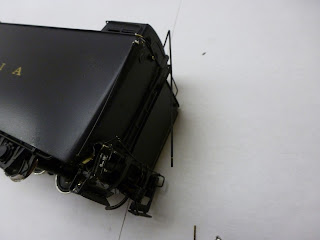The engine then rolled over at some speed and crushed the headlight into the boiler. The smoke box front exploded off the engine with that blow. It took some time to find it as it was at some distance from the wreck.
This is what happened to the pilot truck. It must have whipped around and then been bent by the cylinders.
The tender remained coupled to the engine until it hit the floor. It bent the drawbar into a U shape and tore off the cab apron before it separated.
The rear of the tender then whipped down and hit the floor, crushing the tail beam on one side and ripping off the base of the antenna.
We are hoping that the shop forces can repair this engine and upgrade it with the new fixtures that we were planning on putting on the fleet. It has now been moved to the head of the line for attention. Thank good ness it was not one of the engines already rebuilt by Frank Miller. There would not a report in that case, just crying.
Needless to say, the engineer will be disciplined with some time off and subsequent assignment to the shop forces to hone his skills on repair work! We will have to supply after pictures to show what came out.





















